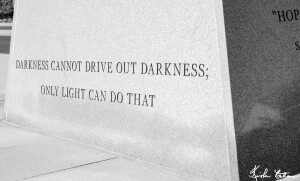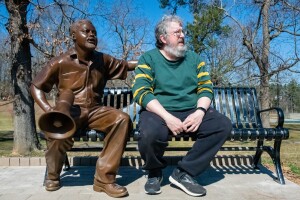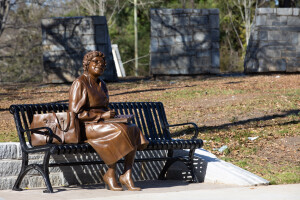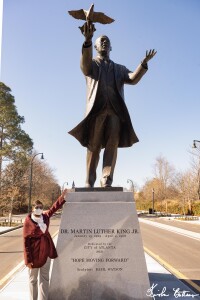New Statues on MLK Drive Celebrate Civil Rights Movement
Photographs of installations courtesy of City of Atlanta.
(APN) ATLANTA — In recent weeks and months, the City of Atlanta has installed new statues on Martin Luther King, Jr. Drive on Atlanta’s Westside honoring Dr. King as well as other civil rights heroes.
First, in January 2021, the City installed a monument dedicated to Dr. King on MLK Drive by Northside Drive in Atlanta’s Vine City neighborhood, near to the Mercedes Benz Stadium.
 Dr. King’s likeness is situated upon a trapezoidal base, bearing the words, “DARKNESS CANNOT BEAR OUT DARKNESS; ONLY LIGHT CAN DO THAT”; and “IF YOU CAN’T FLY THEN RUN, IF YOU CAN’T RUN THEN WALK, IF YOU CAN’T WALK THEN CRAWL.”
Dr. King’s likeness is situated upon a trapezoidal base, bearing the words, “DARKNESS CANNOT BEAR OUT DARKNESS; ONLY LIGHT CAN DO THAT”; and “IF YOU CAN’T FLY THEN RUN, IF YOU CAN’T RUN THEN WALK, IF YOU CAN’T WALK THEN CRAWL.”
The statue of Dr. King was created by the internationally renowned Jamaican-born sculptor Basil Watson.
“This sculpture is a fitting and timely tribute to Atlanta’s son, Dr. King,” Mayor Keisha Lance Bottoms said in a press release.
“Atlanta is the cradle of the Civil Rights movement and is the birth home and final resting place of Dr. King… Thank you to all who had a role in creating this tribute sure to inspire generations of Atlantans.”
Then, in February 2021, the City installed four bronze sculptures, each attached to a bench adorning the frontage of Mozley Park, also on MLK Drive.
 The sculptures honor Dr. Rita Samuels; Dorothy Bolden; Rev. Hosea Williams; and W.A. Scott. The sculptures are situated such that it appears that each of the honorees are seated in the benches where they are installed. Rev. Williams is depicted shouting into a megaphone.
The sculptures honor Dr. Rita Samuels; Dorothy Bolden; Rev. Hosea Williams; and W.A. Scott. The sculptures are situated such that it appears that each of the honorees are seated in the benches where they are installed. Rev. Williams is depicted shouting into a megaphone.
 Dr. Samuels passed away in 2018.
Dr. Samuels passed away in 2018.
http://atlantaprogressivenews.com/2018/04/06/dr-rita-jackson-samuels-1945-2018-presente/
“I am truly glad that they recognized her,” Helen Butler, Executive Director of the Georgia Coalition for the People’s Agenda, told Atlanta Progressive News.
“She had done a lot of work in the City of Atlanta and across the State, especially for women lifting up women. She was one of the founders of the Atlanta Commission on Women, and the Georgia Commission for that matter. It’s a great honor to her and a salute to her work,” Butler said.
“She has started with Dr. King at the age of nineteen,” Butler said of Dr. Samuels. “She worked with Jimmy Carter, the first Black [person] in the Governor’s office.”
“I’m hoping it will be a beacon of light to some young person that she started as a teenager in the movement. It’s just an honor to see people who struggled to make life better for more than themselves,” Butler said.
Former State Rep. “Able” Mable Thomas (D-Atlanta) said she likes the installations.
“I like ‘em. Some of my heroes are being featured, so I do like it. I’m glad more emphasis is being put on arts and culture. When you can put arts, culture, and civil rights together, I think it’s a winner.” Rep. Thomas told APN.
But not all community leaders were pleased.
Bishop John Lewis, III, is distressed that Dr. King’s back is facing the Vine City community.
“With his back turned to the beloved community. They may say it is a welcome to the community, but as one who is from the community, his back is turned to the community – why is that?” Lewis said.
“All those statues, and people sitting in front of Mozley Park, Ms. Bolden did not live in Mozley Park, she lived in Vine City. You don’t even know the history,” Lewis said.
“I remember when Mozley Park was integrated. That park was not for Black, African Americans. I have mixed emotions about them all,” he said.
“The community wasn’t even invited to the ribbon cutting – we had to see it when anybody else saw it. We need to be more mindful,” he said.
“There were people right there in that Mozley Park community who were fighters. Some of the names who have not been called who have been instrumental on the Westside, couldn’t we have honored them?” he said.
The statue and monuments are only the first two of seven public art installations commissioned for the City’s 3.7 million dollar MLK Innovation Corridor Project.
According to the City of Atlanta, the four sculptures were selected by a committee with representatives from the Mayor’s Office of Cultural Affairs, the Mozley Park community, and local artists, after a national call for artists in January 2018.
“I don’t doubt that they had a meeting with some folks, but they selected, they really pick ‘em. All that stuff is slanted,” Rev. Lewis said.
“The folks who live in that [community], nine out of ten of them don’t know nothing about what happened in that community. The people that know what happened, they’re dead.”
The MLK Corridor Project, managed by the City of Atlanta’s Department of Transportation, spans approximately 7.2 miles from Northside Drive to Fulton Industrial Boulevard.
This project addresses vehicular, disability, and pedestrian safety concerns, while providing additional pedestrian and bicycle access by implementing new multi-use trails.
A portion of the project, from Ollie Street to Northside Drive, is substantially complete, with the remainder of the project from Ollie Street to Fulton Industrial Boulevard expected to be completed by spring 2021.
Work also includes a protected bike and pedestrian facility from James P. Brawley Drive to Northside Drive.
(END / Copyright Atlanta Progressive News / 2021)
